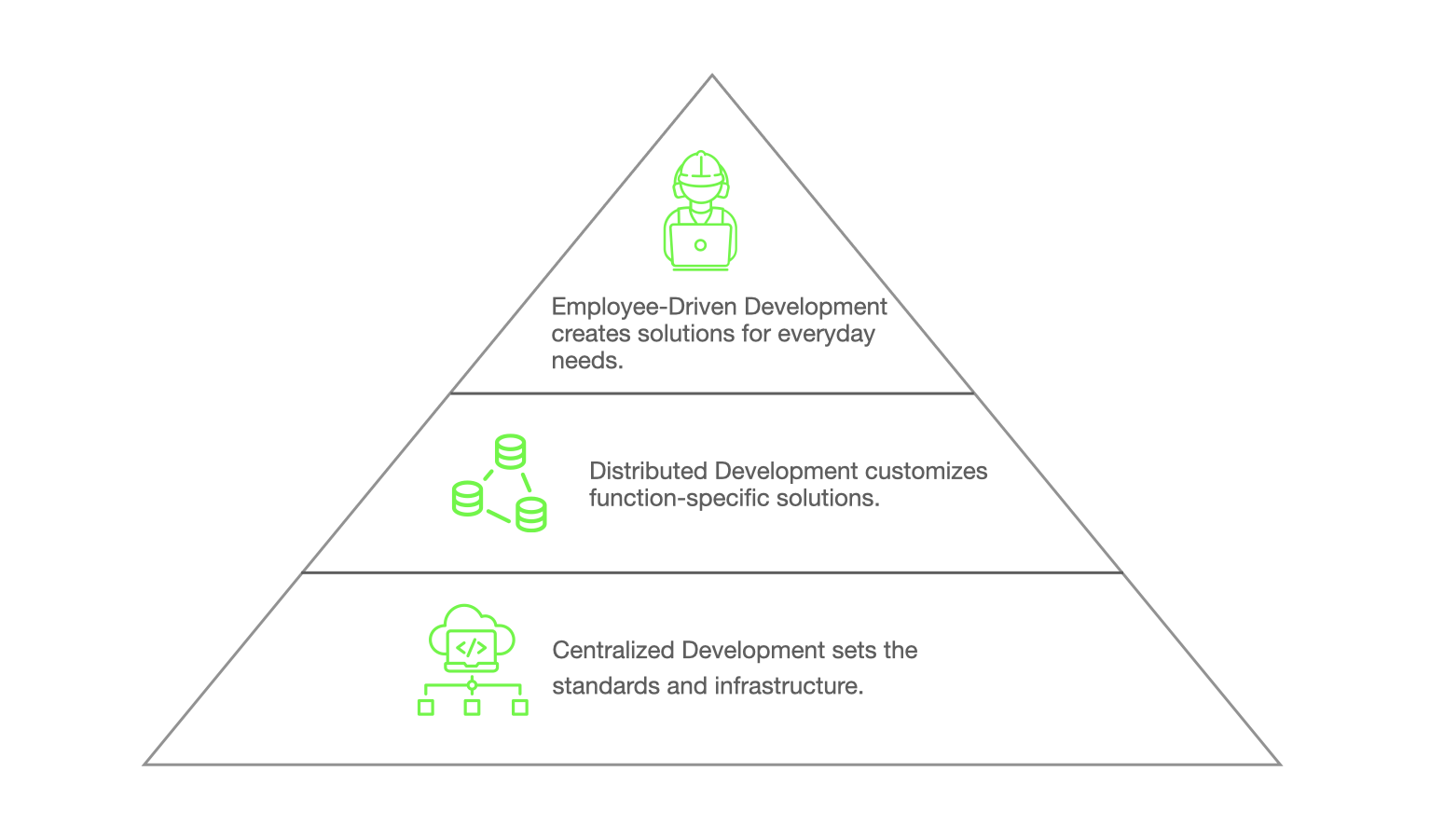Most AEC companies rely on off-the-shelf software, which they customize using in-house templates, libraries, and workflow automation. However, if this approach becomes too restrictive, firms often partner with external software developers or establish internal coding teams to create tailor-made tools.
While custom software development can address urgent and specific needs, it comes with significant costs, both for initial development and ongoing maintenance.
Recently, a growing interest has emerged around no-code and low-code platforms like Quickbase. These platforms empower employees across departments to build custom apps suited to their daily workflows without requiring deep programming skills.
Approaches to Software Development in AEC
Beyond creating software, organizing the development process within a company is equally crucial. AEC companies adopt various organizational models for software development, reflecting their size, complexity, and strategic focus.
IT-Driven Development
In the traditional IT-driven model, centralized IT teams manage the procurement, customization, and development of software solutions across the company. This model is common in construction firms as it ensures consistency, compliance, and cybersecurity.
However, this centralized approach can sometimes slow down the response to specific user needs and may even block innovative new solutions. One IT director from an AEC firm mentioned that introducing new software carries risks and would require support resources, which their already understaffed department could not afford.
Distributed Development
Some companies opt for a distributed model, where different departments have their own IT teams or software development capabilities. Functions such as design, project management, and construction can develop or customize software tailored to their specific needs.
This model is highly responsive and allows for quick iterations. However, it often results in fragmented software ecosystems, complicating integration across the company. In some cases, departmental teams might even duplicate efforts, working on similar solutions without knowledge of each other’s projects.
Employee-Driven Development
Many employees feel that company tools and technologies do not support their productivity and, in some cases, even hinder it. Employee-driven development addresses this by empowering workers to create or customize tools that align with their day-to-day workflows. This approach taps into employees’ firsthand experience, often resulting in more intuitive and efficient solutions.
Employees are naturally resourceful; they’ll find ways to get their job done with any tools available. I once spoke with a construction site supervisor who used personal smartphone apps to document site issues. He found the company’s “official” tools outdated and impractical for fast-paced work. Interestingly, his company had recently hired software developers to build a new reporting tool, but these coders had never visited a construction site.
The challenge with employee-driven development is ensuring that solutions created “on-site” integrate seamlessly with the company’s technology architecture and adhere to cyber security standards.
Integrating Development for Unified Innovation
All three levels of development—centralized IT-driven, distributed departmental, and employee-driven—can work in harmony.
You can establish a collaborative framework where 1) IT sets the standards and infrastructure, 2) departments customize function-specific solutions to their needs, and 3) employees create solutions for everyday needs within a governed environment. This synergy enables rapid, tailored development while maintaining security, integration, and company-wide consistency.

A Case Study: Quickbase and Boyett Construction
Quickbase demonstrates how to achieve employee-inspired software development in an affordable and secure manner. Boyett Construction, a San Francisco-based subcontractor managing around 150 commercial projects annually, developed its Business Management System (BMS) using Quickbase.
Boyett sought to move away from paper-based processes, which were inefficient and lacked standardization. Their BMS app now serves as a centralized repository for project information, sourced from over 30 roles and several corporate systems. It includes customized dashboards, automatic notifications, and reports that even facilitate the generation of one-off reports within minutes.
With BMS, Boyett can efficiently track multiple concurrent projects, coordinate thousands of actions, and avoid delays or customer losses. It has also improved their efficiency in collaborating with material suppliers, such as ASSA ABLOY, leading to substantial sales increases.
Maria Acuna, a member of the team that built the app, noted, “The BMS app can handle everything we want it to do; I’d put it up against any ERP system.”
How to Succeed in Employee-Driven Development
Employee-driven development doesn’t have to be chaotic. Platforms like Quickbase offer no-code and low-code development environments while ensuring integration with other company software and maintaining cybersecurity.
AI is making this development approach even more accessible. For example, Quickbase uses AI to help users create apps simply by describing their goals—a potential game-changer for productivity in employee-driven development.
View the original article and our Inspiration here


Leave a Reply